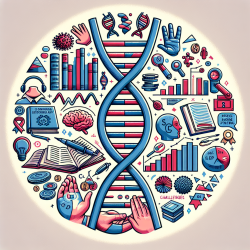Introduction
The quest to understand the roots of verbal ability has led researchers to explore both socioeconomic (SES) and genomic factors. Recent research published in NPJ Science of Learning titled "Socioeconomic and Genomic Roots of Verbal Ability from Current Evidence" provides compelling insights into how these elements interact to shape verbal ability among youth in the United States. This blog will delve into the findings of this research and discuss how practitioners can leverage these insights to improve outcomes for children.
The Study's Core Findings
The study utilized data from the National Longitudinal Study of Adolescent to Adult Health (Add Health), involving 7,194 youth aged 12-18. It combined data from genome-wide association studies (GWAS) and longitudinal SES measures at individual, family, and neighborhood levels. The research found that both SES and genomic measures predict verbal ability effectively, both separately and jointly. Notably, when both predictors are included in the same model, they correct for about 20% of the upward bias in the effect of the education polygenic score (PGS).
Implications for Practitioners
For practitioners in speech-language pathology and education, these findings underscore the importance of considering both genetic and environmental factors when assessing and supporting verbal ability development in children. Here are some actionable insights:
- Holistic Assessment: Incorporate both SES and genetic data when evaluating verbal ability. This approach provides a more comprehensive understanding of a child's potential and challenges.
- Targeted Interventions: Recognize that SES factors such as parental education, income, and neighborhood quality significantly impact verbal development. Tailor interventions to address these environmental factors, alongside genetic predispositions.
- Encourage Further Research: The study highlights the need for more extensive data collection, including DNA data, in social science research. Practitioners should advocate for and participate in research that aims to disentangle the complex interactions between genetics and environment.
Challenges and Future Directions
While the study confirms the importance of SES and genomic factors, it also poses challenges to traditional social-science research, which often interprets SES effects as purely environmental. The findings suggest that about 20-30% of the effects of parental SES are genomic rather than environmental. This revelation calls for a paradigm shift in how SES is modeled in research.
Future research should aim to routinely include DNA data to enhance the understanding of social and environmental influences on verbal ability. This approach will lead to more accurate models and, ultimately, better educational and therapeutic strategies.
Conclusion
The interplay between SES and genomic factors in shaping verbal ability is complex yet crucial for practitioners to understand. By integrating these insights into practice, speech-language pathologists and educators can better support the development of verbal skills in children, leading to improved educational and life outcomes.
To read the original research paper, please follow this link: Socioeconomic and Genomic Roots of Verbal Ability from Current Evidence.










